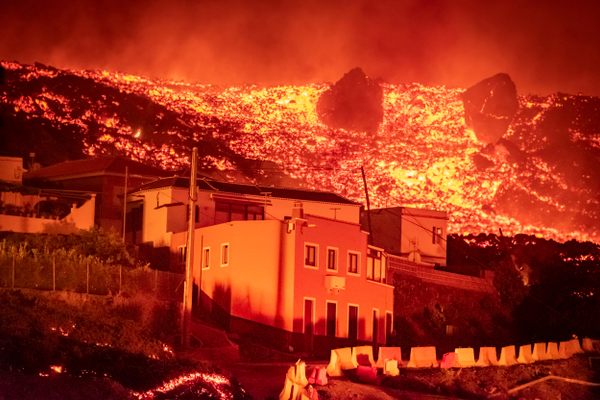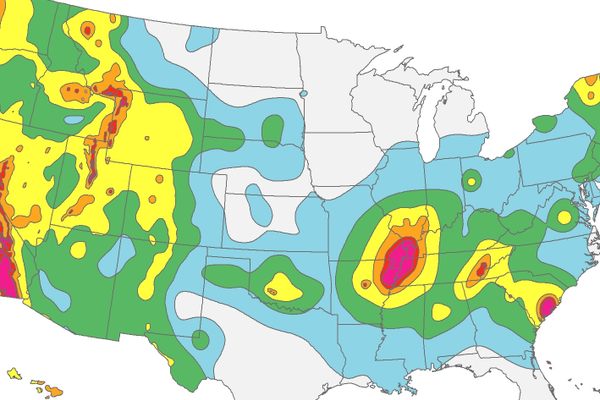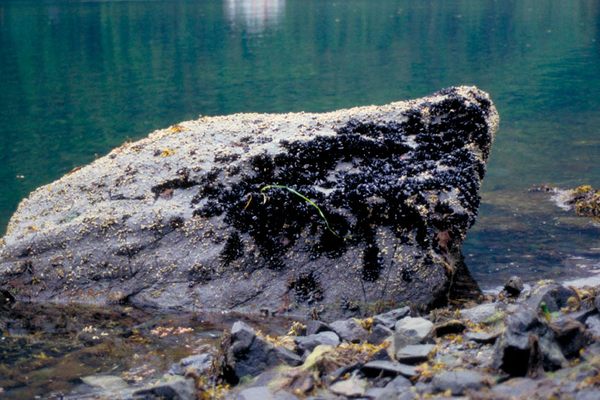Apocalypse Now?: Five Places That Could Destroy the World
Woodcut from the Cologne Bible of 1479 representing the Four Horsemen of the Apocalypse. (via Wikimedia)
We live in an age when the apocalypse has become passé. From street preachers with placards to ancient Mayan prophecies, the notion of the “end times” is bandied about with such careless enthusiasm that the very words themselves have been rendered meaningless. We can’t even open a newspaper these days without being confronted by catastrophic earthquakes, nuclear arms races, or ill-advised scientific experiments.
In this guide, however, we’re going to be taking a look at five places that could pose a realistic threat to our continued existence on this planet. So buckle your seatbelt and dust off the ration packs, as you join us on a tour of places that could destroy the world.
FUKUSHIMA NUCLEAR POWER STATION
Fukushima, Japan
The Nuclear Power Plant at Fukushima in Japan has been making regular news ever since its catastrophic systems failure on March 11, 2011. Since then, much of the media hype has died down, leaving the plant’s team to get on with the clean-up operation. However, some experts are claiming that we should be paying more attention to Fukushima right now.
Reactor control room at Fukushima Nuclear Power Plant (photograph by Kawamoto Takuor)
The accident happened when the 2011 Tōhoku earthquake caused a tsunami, hitting the power plant and instigating a double core meltdown. As many as 300,000 people were evacuated from the area, and the Fukushima disaster became the largest radiological event since the Chernobyl disaster in 1986 — earning a rating of Level 7 on the International Nuclear Event Scale.
At first, that seemed to be the extent of the crisis. Without undermining a figure of almost 1,600 deaths believed to have been caused as a result of the rushed evacuation, or the forecasted increase in the local susceptibility for conditions such as cancer or leukemia, the radiation appeared at least to be contained.
The Fukushima Nuclear Plant after the earthquake and tsunami (via Digital Globe)
However, things weren’t so simple. When the reactor was struck, thousands of tons of contaminated water leaked out of the plant, into the earth, and eventually to the Pacific Ocean. This uncontrolled radioactive waste has caused untold damage to the fishing industry, while the continuing clean up operation still poses severe risks that could have catastrophic effects worldwide.
Writing in the World Nuclear Industry Status Report, independent consultants Mycle Schneider and Anthony Froggatt claimed:
“Full release from the Unit-4 spent fuel pool, without any containment or control, could cause by far the most serious radiological disaster to date, releasing three times the radioactive material of the 1986 Chernobyl disaster, or 14,000 Hiroshimas.”
Radiation hotspot in Kashiwa, near Fukushima (via Wikimedia)
The full danger of the ongoing disaster at Fukushima has only gradually come to light, and many have accused the Tokyo Electric Power Company of dealing with the meltdown in a secretive and incompetent fashion. Staff are now preparing to extract unstable radioactive fuel rods from the wreckage, in something akin to an apocalyptic, crane-operated version of the game Pick-up sticks. One clumsy move, and it’ll be the worst manmade disaster in history.
A few expert commentators are already recommending a full evacuation of the Northern Hemisphere. Scientist David Suzuki went on record saying, “everyone on the West Coast of North America should evacuate.” While Suzuki was labelled a scaremonger by some, and later expressed his regret at making such an extreme statement, he did not however deny his belief in such a dire prognosis; and the Center for Research on Globalization is just one of many websites to have collected similar concerns from a range of respected scientists.
Even if calling for a widespread evacuation of the Northern Hemisphere proves to be an overreaction, it cannot be overstated just how serious of a catastrophe this event has been — and will no doubt continue to be in the years to come.
Fukushima Power Plant prior to the disaster (via Wikimedia)
THE KOREAN PENINSULA
The threat of global nuclear war has existed since the technology itself came into being, so perhaps to pin that threat onto one specific place is to undermine the size and scale of the dangers posed by worldwide nuclear armament. Nevertheless, a list like this wouldn’t be complete without a mention of “the bomb,” and in the last year in particular, that threat has been linked most frequently to North Korea.
The statues of Kim Il Sung and Kim Jong Il in Pyongyang (photograph by J.A. de Roor)
In 2013, tensions on the Korean Peninsula escalated to new levels of hostility, and for a time the threat of nuclear engagement felt closer than it had since the Cold War. As the United States moved more and more of its armed forces into South Korea, the embittered North Korea released news of an underground nuclear test on February 12, and then in May launched a test missile into the Sea of Japan. The two tests, combined, represented a grave threat for the nation’s perceived enemies; though analysts believed that North Korean technology was as yet incapable of delivering a nuclear payload as far as the United States, as they had threatened.
By April of 2013, North Korea’s government was making threats of nuclear bombardment. To make matters worse, Japan vowed that if any of these test projectiles entered Japanese air space, it would be considered a breach of the uneasy peace between the two countries.
Though the 2013 saber rattling ended in a begrudging cease-fire between North and South Korea, the north has far from abandoned its nuclear armament programs.
Unha-9 rocket model (photograph by Steve Herman/VOA)
The Institute for Science and International Security estimates North Korea currently possesses between 12 to 27 warheads; in 2013, the Stockholm International Peace Research Institute gave a more conservative estimate of 10. However, thanks to a naturally occurring resource of uranium ore, it’s almost certain that their nuclear arsenal will continue to grow over the coming years.
According to the Federation of American Scientists, there now exists somewhere in the region of 17,300 nuclear warheads globally. Those countries armed, in order of estimated firepower, are: Russia, the United States, France, China, the United Kingdom, Israel, Pakistan, India, and North Korea. Only five of these nine are members of the Nuclear Non-Proliferation Treaty, and there are enough historical rivalries between these countries to prompt serious concern all around.
We can’t help but wonder what would actually happen, should the warheads start flying. According to the experts at Physics Today, it would take 100 nuclear bombs to bring about a full “nuclear winter,” with massive fallout and the lowest temperatures this planet has seen for a millennium. And 1,000 bombs? Well, by that same reckoning we could say goodbye to the human race.
Victorious Fatherland Liberation Monument in North Korea (photo by Hanneke Vermeulen)
BEIJING GENOMICS INSTITUTE
Beijing, China
The Beijing Genomics Institute (BGI) is one of the world’s leading centers for genome sequencing; that is to say, research into the very building blocks of human DNA.
An ABI PRISM 3100 Genetic Analyzer (photograph by Mark Pellegrini)
Amongst the many accolades of the BGI, they are able to claim responsibility for sequencing the first ancient human’s genome, as well as sequencing the first giant panda genome. The institute has successfully sequenced genomes for plants such as soybean, rice, and cucumber, in addition to honeybees, lizards, silkworms, and more than 1,000 forms of bacteria. It is reported that the BGI produces over 500 cloned pigs each year, for use in chemical testing.
Advances such as these have led to the development of proposed eugenics programs, which (among other effects) would allow would-be parents to select their offspring before birth, choosing between all of the potential genetic outcomes of their pairing.
Genetically Modified Mice (via Wikimedia)
According to an interview with one of the project’s participants, China predicts that this choice would tend towards the selection of more intelligent offspring; and that as a result, each new generation could be expected to have an IQ score that averages 15 points higher the random norm. Over the course of a century or so of improvements — each generation smarter, faster, and stronger than the last — descendants of the project will be effectively evolved into the ultimate, genetically enhanced (potential) master race.
In the West, such experiments are generally countered by a wave of religious-based fears about meddling with “God’s design”; even the word “eugenics” still rattles from association with the Nazi experiments of WWII. China, meanwhile, apparently unhindered by such stigma, is currently leading the way in the global genome race.
The first printout of the human genome in book form, at the Wellcome Collection in London (photograph by Russ London)
It isn’t just the religious amongst us, though, who feel that tampering with human DNA just might not be that great of an idea. We’re not quite at the stage of test tube-grown clone armies however, and the chances of accidental mutation may seem equally unlikely. For now, China’s reported eugenics program is something of a slow burner and we’re not likely to see the results for a long time yet.
CENTER FOR DISEASE CONTROL
Atlanta, Georgia, United States
The United States Center for Disease Control and Prevention (CDC) runs a number of research and treatment facilities across the United States. Its headquarters in Atlanta contains enough dangerous contagions to fuel a serious epidemic — rabies, bird flu, tuberculosis, monkeypox, and more. Of course, these hazardous samples are stored under the tightest of security, in a state-of-the-art biosafety department built at a cost of $214 million in taxpayers’ money. Today, the CDC is one of the only two official smallpox repositories in existence.
The CDC Headquarters in unincorporated DeKalb County, Georgia (via Wikimedia)
The complex itself is an imposing, industrial affair, as you might well expect from a facility with such a need for airtight security. Before you get too comfortable though, on February 16, 2012, there came proof that even the CDC’s own biosafety procedures were fallible: in the form of an air leak from Building 18.
According to congressional sources, an air filter backfired in one of the building’s germ labs and air destined for the powerful HEPA cleaning filters was channeled the wrong way — back into a clean-air corridor outside the laboratory. There were even visitors in the corridor at the time, who reported a puff of air blowing through the hatch on a lab door.
As luck would have it, there were no experiments being conducted in the laboratory at that precise moment. Had there been, those touring visitors could have been exposed to any number of deadly contaminations.
Electron micrograph of malaria (via Wikimedia)
On the CDC’s own website, a tongue-in-cheek feature offers advice to citizens in the case of a zombie outbreak, but if ever there were to be an aggressively contagious global biohazard disaster, the CDC itself is one of the few facilities on the planet with the means of instigating it. As a matter of fact, in May of 1994 the CDC admitted to having provided the Iraqi government with “biological warfare agents” between the years 1984 and 1993; a heinous list of contagions including West Nile virus, Dengue fever, and Botulinum toxin — the most acutely toxic substance in the world.
When pressed on the subject, CDC lab director Thomas Monath described the transaction as the “free exchange of biological samples among medical researchers.”
YELLOWSTONE CALDERA
Wyoming, United States
Famous for its majestic bison, belching geysers, breathtaking mountain scenery, and diverse ecosystems, most people wouldn’t immediately associate Yellowstone National Park with the threat of global disaster. As it stands though, the Yellowstone Caldera is one of the more likely contenders on our list, based on the simple logic that what has happened three times already, can probably happen again.
The 1990 eruption of Alaska’s Mount Redoubt would be dwarfed by Yellowstone’s supereruption (via United States Geological Survey)
The caldera we know today was formed 640,000 years ago, a byproduct of the explosive Lava Creek eruption. Previous to that was the Mesa Falls eruption dating 1.3 million years ago, and further back still, the Huckleberry Ridge eruption at 2.1 million years ago. Suffice to say, it doesn’t happen very often, but packing a punch quite unlike any volcano we’ve seen before, once would be enough for us.
To give a sense of scale, in 2010 the volcano Eyjafjallajökull erupted in Iceland, bringing air travel to a halt across the UK and the majority of northwest Europe. Data suggests that Yellowstone’s last eruption produced 600 cubic miles of dust and ash — that’s roughly 10,000 times the size of the Eyjafjallajökull eruption, and even just a series of small eruptions would be enough to bring the entire planet to its knees.
Yellowstone River in Hayden Valley (via National Park Service)
Reading the temper of a supervolcano is incredibly difficult to do, but take a look at the intervals between the Yellowstone Caldera’s past eruptions: 800,000 years between the first two, 660,000 years between the second and the third… and now 640,000 years since the last. Could it be that we’re due for another sometime soon?
The truth is, Yellowstone could erupt next year. It could erupt this year for all we know, wiping out half the Western States before your next birthday. The world’s leading volcanologists are betting 10,000 against one, however, that it isn’t going to happen within our lifetimes.
Although having said that, there is the “Ring of Fire” to consider.
Tuff Cliff in Yellowstone Park, formed by the Lava Creek eruption (via National Park Service)
In case you haven’t heard of it, the Ring of Fire is a series of both active and dormant volcanoes that circles the Pacific Ocean. It falls along the edges of one of the planet’s main tectonic plates, featuring a total of more than 450 volcanoes. Recent quakes in Japan, New Zealand, and Chile can all be attributed to the Ring of Fire, which locates 90% of the world’s earthquakes in addition to 75% of its active volcanoes.
Somewhat alarmingly, the volcanoes comprising the Ring of Fire have seen a noted increase in activity over the last six months. There have now occurred ten major eruptions in that time, including some sites which have been dormant for decades until now.
Just recently, Ring of Fire volcanoes have erupted in Japan, Indonesia, Mexico, Guatemala, and the Kamchatka Peninsula of Russia. As the ring also includes the entire West Coast of the USA — as well as the south coast of Alaska — some are now predicting that Americans, too, should be preparing for the very real threat of volcanic activity.
The Pacific Ring of Fire (via Wikimedia)
It’s a sobering thought that for all our nuclear warheads, our genetic research, atmospheric interference, and laboratory-born black holes, the human race might yet meet its demise at the hands of Mother Earth herself. But then, looking back along this list of manmade horrors, weapons of mass destruction, and attempts at playing God, perhaps one could hardly blame her for wanting to shake us off.
Of course, it’s probably going to be fine. We most likely have nothing to fear from any of the five places listed above; but whatever that thing is that you keep talking about and still haven’t quite gotten around to doing yet… well, now might be the time.















Follow us on Twitter to get the latest on the world's hidden wonders.
Like us on Facebook to get the latest on the world's hidden wonders.
Follow us on Twitter Like us on Facebook